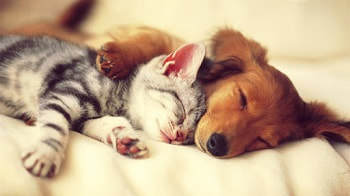Snuggle Fondle Cuddle
 What do these three verbs have in common? Hmmm? I know—they all end with the letters ‘le’. For some verbs, this ‘le’ ending suggests the repetition or intensity of an action. Can you see where this might be going?
What do these three verbs have in common? Hmmm? I know—they all end with the letters ‘le’. For some verbs, this ‘le’ ending suggests the repetition or intensity of an action. Can you see where this might be going?Snug, Snuggle
The word snug perhaps has its origins in Proto-Indo-European (PIE) kes(1) (to scratch) and in Scandinavian sources such as Old Norse snoggr (short-haired) and Old Swedish snygg and Old Danish snog (neat, tidy). By the 1590s, the word snug had come to English meaning compact and trim, especially in terms of a ship protected from the weather (i.e., ‘shipshape’).
The use of snug to meaning ‘to be in a sense of ease or comfort’ is from the 1620s. Snug meaning ‘to fit closely together’ (e.g., to ‘snug down’ your gear or your boat; or, in carpentry, to snug two pieces of word together; or, when, for some reason, two people chose to fit closely together) is from 1838. The expression ‘snug as a bug in a rug’ is from 1769.
When ‘le’ was added to snug in the 1680s to form snuggle, it suggested a frequency or intensity of comfort or of fitting closely together.
Fond, Fondle
The word fond comes from the early 14th century Middle English fonne (a fool, a stupid person) and fonnen (to be foolish, to be simple). By the late 14th century, the word fond came to English meaning deranged, insane (also, foolish, silly, unwise).
The words fonne and foonen are also the origin of the word fun. But that’s another story.
Fond, meaning ‘foolishly tender’ or ‘having strong affections for’ is from the 1570s.
When ‘le’ was added to fond in the 1690s to form fondle, it meant ‘to treat with indulgence and affection’. Fondle, in the sense of ‘to caress’ is from 1796.
Cuddle
Unlike the two words above, ‘le’ is not added to cudd to form cuddle. Rather, cuddle comes from the PIE root kwel(1) (to revolve, to move around) and kwol-o- (neck). From this source comes Latin collum (neck) and collare (necklace), then Old French coler (neck, collar), and by around 1300, the word collar (neck armor, something worn around the neck) had come to English. By the mid-15th century a collar was something could be worn by a person, a dog, a horse, or other animal.
What’s the connection to cuddle? The verb ‘to cuddle’ (to hug, to embrace so as to keep warm; to lie close or snug), from the 1520s, has uncertain origins. However, some suggest it may have originated in English as cull or coll (to embrace) from the word collar. Also, some suggest that the word was first used in relation to comforting small children by an embrace; for example, putting your arms around a child or putting your arm around a child’s shoulders.
Cuddle meaning a hug or an embrace for anyone is from 1825.
The word cuddle has nothing to do with the word cuddy. In medieval English, a cuddy was slang term for a horse or donkey. Also, Cuddy was an informal shortening of the name Cuthbert, just as Tom is short for Thomas and Dick is short for Richard (Liberman, 116, 119).
(By the way, I never thought that I’d ever post a such a picture on social media. I think that Covid is starting to get to me.)
Reference
Liberman, A. (2009). Word origins: And how we know them. Oxford: OUP.
Online Etymological Dictionary, https://www.etymonline.com/
Image: http://douglassquarepetclinic.com/
Published on January 16, 2021 20:34
No comments have been added yet.



